Rural students face barriers to elite college admissions
This article was created by AI summarizing key points discussed. AI makes mistakes, so for full details and context, please refer to the video of the full meeting. Please report any errors so we can fix them. Report an error »

Rural students face significant barriers in accessing elite higher education, as highlighted in a recent government meeting focused on educational equity. The discussion revealed that rural college completion rates are 15% lower than those in urban areas, with New Mexico ranking last in education and third to last in child economic well-being. Many rural districts, such as Cuesta, operate on a four-day school week and struggle with limited budgets, which restricts the availability of advanced placement (AP) and honors classes.
Cuesta student Dominguez noted the lack of advanced courses, stating, \"It's not enough... there are certain courses that you just don't... they don't offer here.\" This limitation can hinder students' ability to meet the admissions requirements of competitive colleges. Paige Cook, an admissions officer from Columbia University, emphasized that colleges consider the resources available to applicants, which can impact their evaluation of a student's efforts within their school's curriculum.
Bentley from the University of Chicago pointed out that while many competitive colleges are committed to improving access for rural students, representation remains low. Currently, only 3% of students at her institution come from rural and small-town high schools, despite these areas comprising over 30% of the U.S. population. The underrepresentation is attributed to both a lack of applications from rural students and challenges in the admissions process.
Bentley leads a network of colleges aimed at expanding opportunities for rural students, assuring them, \"You are wanted. You are welcomed. We value you.\" She reported progress at her institution, where the percentage of rural students has increased to 9%, signaling a growing recognition of the importance of diverse perspectives in higher education.
Cuesta student Dominguez noted the lack of advanced courses, stating, \"It's not enough... there are certain courses that you just don't... they don't offer here.\" This limitation can hinder students' ability to meet the admissions requirements of competitive colleges. Paige Cook, an admissions officer from Columbia University, emphasized that colleges consider the resources available to applicants, which can impact their evaluation of a student's efforts within their school's curriculum.
Bentley from the University of Chicago pointed out that while many competitive colleges are committed to improving access for rural students, representation remains low. Currently, only 3% of students at her institution come from rural and small-town high schools, despite these areas comprising over 30% of the U.S. population. The underrepresentation is attributed to both a lack of applications from rural students and challenges in the admissions process.
Bentley leads a network of colleges aimed at expanding opportunities for rural students, assuring them, \"You are wanted. You are welcomed. We value you.\" She reported progress at her institution, where the percentage of rural students has increased to 9%, signaling a growing recognition of the importance of diverse perspectives in higher education.
View full meeting
This article is based on a recent meeting—watch the full video and explore the complete transcript for deeper insights into the discussion.
View full meeting